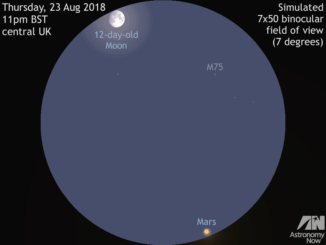
A subtle orbital adjustment has enabled the Emirates Mars Mission – Hope – to repeatedly fly past the martian moon Deimos, capturing stunning bird’s eye view portraits of the oddly shaped moon with the red planet below.
Observations unveiled during a special session at the European Geosciences Union General Assembly included high-resolution images taken during the spacecraft’s closest approach to date, along with hyper-spectral data in the thermal infrared and the first-ever images of Deimos in the extreme and far ultraviolet.
The fly-by images, some captured within 100 kilometres (62 miles) of the moon’s surface, also provide the first high-resolution views of Deimos’ far side. The data indicate a composition more consistent with a planetary origin than what one might expect of a captured asteroid.
“We are unsure of the origins of both Phobos and Deimos,” said EMM science lead Hessa Al Matroushi. “One long-standing theory is that they are captured asteroids, but there are unresolved questions about their composition.”
Instrument scientist Christopher Edwards said the new observations of Deimos roughly match earlier looks at Mars’ other moon, Phobos.
“Much like data acquired of Phobos indicate its composition is not consistent with a captured D-type asteroid, early results from (Hope’s) observations of Deimos tell a similar story,” he said.
“Both of these bodies have infrared properties more akin to a basaltic Mars than a D-type asteroid such as the Taggish Lake meteorite that is often used as an analog for the spectral properties of Phobos and Deimos.”
Launched 19 July 2020 atop a Japanese H-2A rocket, the Hope probe braked into a highly elliptical orbit around Mars on 9 February 2021. The spacecraft’s orbit was recently adjusted using a technique known as a Lambert transfer, setting up repeated flybys of Deimos. The first such close encounter came in late January.
With a radius of just 6.2 kilometres (3.9 miles), Deimos orbits Mars at a distance of about 23,400 kilometres (14,500 miles).
Hope’s current 55-hour orbit has a high point of 43,000 kilometres (26,700 miles) and a low point of 20,000 kilometres (12,400 miles). It will continue its mission to study the martian atmosphere while opening a new window on tiny Deimos.
“We have a unique opportunity with Hope to characterise the composition, thermophysics and detailed geomorphology of Deimos with these new observations,” said Justin Deighan, EMM deputy science Lead. “We expect to build a better understanding of both Phobos and Deimos’ origins and evolution and advance our fundamental understanding of these two satellites of Mars.”



